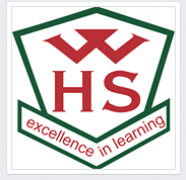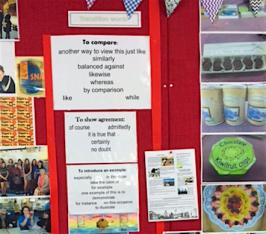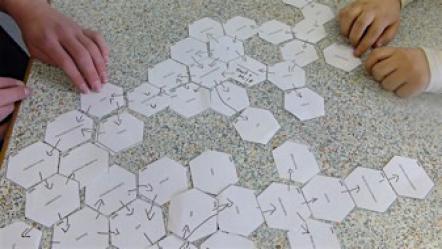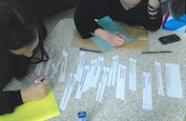Explicit literacy focus improves learning in food technology
Secondary teacher Marietjie van Schalkwyk has found that regular and explicit teaching in literacy has improved students' learning outcomes in food technology programmes.
 Why focus on literacy in technology?
Why focus on literacy in technology?

The students at Wellington High School come from a range of cultural backgrounds, and for some English is their second language, as it is for their teacher Marietjie.
Marietjie understands that technology students need support with literacy because the evidence they have to produce for NCEA in technology demands literacy skills.
In addition, several technology NCEA achievement standards provide opportunities for students to meet requirements for literacy standards. (See Literacy and numeracy assessment standards.)
It took a while for her students to grasp the purpose of work on literacy, but Marietjie was pleased to hear students eventually say, “Oh you mean we have to write like we do in English!”
NCEA results
Marietjie’s classes that included explicit literacy teaching and learning achieved higher results than expected.
Achievement standard 91643: Implement complex procedures to process a specified product (internal)
Grades predicted at the beginning of the year showed students mainly in the not achieved/achieved categories and generally working below level 8 of the curriculum.
The final results were nine achieved, three merit, and two excellence grades (with one that did not submit).
Achievement standard 91644: Demonstrate understanding of combined preservation mechanisms used to maintain product integrity (external)
Ten of the 15 students submitted for the initial formative assessment.
Formative judgements suggest that five students were working at merit, four at achieved, and one at excellence.
So what is literacy and where do I start?
Literacy Online (at Literacy in the learning areas) quotes from The New Zealand Curriculum in describing how students need to learn:
- the specialist vocabulary (of technology)
- how to read and understand its texts
- how to communicate its knowledge and ideas in appropriate ways
- how to listen and read critically, assessing the value of what they hear and read.
Marietjie developed her own understandings of teaching literacy. From this, she developed a teaching inquiry focused on improving students’ literacy to raise their achievement in technology.
Tips and strategies
Identifying students' literacy learning needs
At the beginning of the year, Marietjie used activities to gather information about students’ literacy levels.
For example, she asked students to describe, explain, and then discuss an image of an apple.
Through these activities, Marietjie identifies ways some students will need extra support in literacy and plans for working closely with these students throughout the year.
Describe, explain, and discuss
The image activity also provides an opportunity to introduce students to the NCEA definitions of describe, explain, and discuss. These terms are included in the NCEA technology achievement standards.
Oral communication is key in developing these understandings. In discussions throughout the year, Marietjie prompts students to use terms signalling relationships – asking “because?”, and “so that? …”
She encourages students to extrapolate on their initial statements and move their statements to explanation and discussion rather than just description.
Analysing food products
Analysing their own and others’ food products provided more opportunities to grow students’ capabilities in explaining and discussing.
Marietjie used prompts, such as the following about choux pastry products:
- Can you describe the outcome? What are its physical properties?
- What are the ingredients used in this choux pastry? What are the functional properties of each of these?
- What process was used to make each of these pastries and how did each process differ?
- Discuss why these two pastries have different physical properties based on your knowledge of the functional properties of the ingredients and the processes followed in their making.
Transition words and phrases

Transitions words and phrases provide connections between ideas, sentences, and paragraphs.
Transitions help to make a piece of writing flow better, signal relationships between ideas, and unify the writing.
Marietjie has charts of transition words and phrases on the classroom walls.
Students are regularly prompted to use these when they are working together discussing, reading, and writing.
Marietjie provides scaffolding through activities in which students practice using the different kinds of transition words and discuss how these alter the meaning of sentences.
Having students highlight the transition words in their writing and revising paragraphs by adding in others has also proved an effective strategy.
She finds that just giving the students the vocabulary as handouts or posting them on the classroom walls with some initial teaching is simply not enough. The students need regular and explicit coaching and practice throughout the year to embed literacy understandings and visibly improve in their writing.
Reading and analysing research
In year 13, Marietjie places an emphasis on the role of preservation in developing food products. This topic allows for broader discussions on world food supply and the importance of preservation in providing a regular supply of food.
Students begin developing their understandings by reading and analysing articles on food preservation.
A SOLO (Structure of Observed Learning Outcomes) taxonomy strategy described by Pam Hook is used to monitor their progress and suggest the next steps for students to increase their levels of understanding of these articles. See HookED.
Marietjie uses the free hexagon templates available as downloads at HookED: Free HookED SOLO Resources.
The students are asked to write the keywords and statements from the article on pieces of paper cut into hexagons, and place them together in a meaningful order.
Students that have developed a higher level of understanding are able to create tessellations of the hexagons with statements on how the various points are linked.


